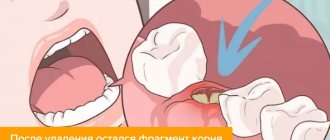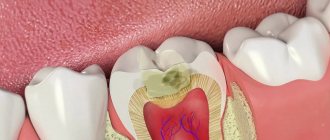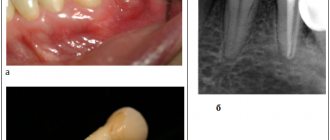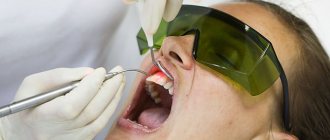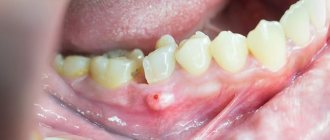The appearance of our front teeth plays a very important role in how others perceive our appearance. They are not only the first thing that catches your eye when you smile, but they are also more likely to be injured than others. You hear a lot from patients who have had a piece of their tooth chipped : “I couldn’t dodge a blow during training,” “I had nothing to open a bottle of beer with,” “I chewed on a caramel.” Enamel, which is the hardest tissue in the body, does not always withstand falls from a horse and hits from a tennis ball. As a result, chips of various sizes are formed on the cutting edge of the tooth. What can modern dentistry offer in this case?
When do baby teeth start falling out?
During the first three years of life, a child grows 20 baby teeth. At this time, a temporary bite is formed: it is distinguished by a pronounced anatomical shape, thin enamel, and susceptibility to caries. After the first three years, the roots of baby teeth slowly dissolve, making room for a permanent bite. From the age of 4-5 years, baby teeth begin to fall out, and this continues until the fifth or sixth grade of school.
In most cases, the process occurs calmly and does not require third-party intervention, including medical attention. Dentists strongly advise against rushing things.
Possible reasons why a child’s baby tooth has fallen out
The main reason for the loss of baby teeth is the eruption of permanent teeth. The process of replacing baby teeth is preceded by the resorption of their roots. After root loss, the baby tooth becomes loose and falls out. Most often, the process does not cause the child significant discomfort or pain, and the vacated space is subsequently filled with the erupting permanent incisor.
Replacing a baby tooth with a permanent one
Attention! The replacement of baby teeth with permanent ones is a natural process established by nature. Root teeth are stronger and more resilient, they are distinguished by the hardness and density of the enamel, therefore making it easier for the child to adapt to adult food.
The first loss of baby teeth occurs after the child reaches the age of six, which is considered the norm in dentistry. It takes 6 to 8 years for permanent teeth to form.
This is exactly how long it will take for 20 baby teeth to fall out and 32 root teeth to erupt. But due to the individual characteristics of each individual child’s body, minor deviations from the established schedule are allowed.
However, if your first baby tooth falls out at age 4 or even at age 5, you should consult a specialist , as this may be due to improper oral care. Early loss of baby teeth, as well as delays in the schedule, is fraught with serious defects in the developing dentition, and therefore requires supervision by a pediatric dentist.
Why shouldn't you remove baby teeth yourself?
Removal of a baby tooth is considered premature if more than a year remains before a new one appears. This period is difficult to predict accurately, but you can roughly estimate it using a graph with average indicators.
Premature removal of a baby tooth is dangerous because its neighbors will try to take the vacant space. The roots of permanent teeth that are about to emerge will become crowded. The bite will change, which will take a long time to correct. Moreover, there are several strict contraindications for extracting baby teeth:
- Acute inflammatory diseases of the oral cavity.
- Inflammatory diseases of the throat (ARVI, sore throat, etc.).
- It is not recommended to remove teeth for pathologies of the cardiovascular system, kidneys, central nervous system, blood diseases, vitamin deficiency and nutritional dystrophy.
So when your child's first baby teeth start to loosen, don't disturb them and let them fall out naturally. The child's body knows its business.
When a tooth is already loose, it needs to be cleaned very carefully so as not to rush things. If your child is still in kindergarten and his motor skills are not well developed, help him: take ASEPTA® Baby dental wet wipes and wipe the tooth (as well as its neighbors) from the top and sides.
What does a lost baby tooth look like (photos below)?
Many parents, out of ignorance, tend to think that baby teeth do not have roots at all. At the same time, some mothers and fathers are horrified when a developed root system is not found on a lost baby tooth, believing that part of the tooth remains in the child’s gum. Brief information about what a lost baby tooth looks like will help dispel all the myths. A photo of the removed bone formation will provide the best idea of it.
Temporary incisors are identical to permanent incisors in structure, but differ in smaller crown sizes, thinner enamel and the presence of rather wide canals and large pulp. Despite numerous misconceptions, the root system of a baby tooth is present and ensures the proper performance of the functions of grinding food and forming a normal bite.
Pulled out milk tooth with root
The absence of roots in a fallen baby tooth is explained by their resorption at a certain stage of a person’s life to allow permanent bone structures to erupt, which is the norm.
Indications for milk tooth extraction
However, there are several cases when teeth definitely need to be helped to fall out. For example:
- Bottle caries or other caries has damaged more than half of the tooth.
- The tooth has been loose for a long time, but cannot fall out. This makes it uncomfortable for the baby to chew.
- The tooth is broken, the sharp edge scratches the cheek or tongue.
- The root is affected by caries (there is a danger that it will damage the permanent tooth underneath).
- Pulpitis.
- There is inflammation or a cyst on the mucous membrane next to the tooth.
Do not make the decision to remove it yourself: if you see the symptoms listed above, contact your pediatric dentist. He will tell you what treatment is required.
Trying to remove baby teeth yourself at home is dangerous: their thin walls and long roots go too deep into the gums. If you pull out a tooth with a thread or other improvised methods, you can easily disrupt the growth of permanent teeth that are hidden under the milk teeth.
How to extract a child’s baby tooth (at home) –
To begin with, you should wash your hands well, and the child should either rinse his mouth with an antiseptic, or you can spray with an antiseptic spray (for example, Miramistin). If you want to reduce your child’s pain as much as possible, you can purchase the anesthetic Lidocaine, which is sold at any pharmacy. Liberally soak a small cotton ball or gauze swab with the contents of the anesthetic ampoule and apply it to the gum around the tooth (both external and internal). It is best to buy a package of sterile gauze swabs for this, or make them yourself - from a regular sterile bandage.
Hold the anesthetic swab with your fingers for 1-2 minutes. After this, you will need dental floss (such as Oral-b). This is a very strong and at the same time sufficiently thin thread, which is usually used for completely different purposes - to clean the dental spaces from food debris. Using regular sewing thread is much less effective, and they often break, which leads to more and more attempts, i.e. prolongation of this not very pleasant procedure for the child. The removal of a baby tooth in a child is shown in detail in the following video.
How to pull out a baby tooth for a child (video 1) –
After removal, there may be some bleeding. You can spray the wound with an antiseptic and apply a sterile gauze pad over it (for 5-10 minutes), or apply a sterile gauze pad soaked in antiseptic to the wound. And one more very important point - do not torture the child and try to remove teeth that are not very mobile. This risks the fact that root fragments may remain in the wound, and in this case purulent inflammation will certainly develop (24stoma.ru). In addition, you should not remove even mobile baby teeth, in the projection of which there is a purulent abscess in the form of a lump on the gum (this should only be done by a dentist).
After removal, be sure to maintain oral hygiene and monitor whether gum inflammation has appeared in the area of the extracted tooth. Also keep in mind that it will be easiest to remove a baby tooth at home if it is a front tooth. These are single-rooted teeth, and if the crown is sufficiently mobile, the tooth can be pulled out quite easily with floss (dental floss) without damaging the soft tissues of the cheeks and lips. With teeth from the lateral areas of the dentition, things are more complicated, because this means less convenient access. In addition, temporary molars (4-5 teeth) have two roots, and therefore it will be more difficult to remove such teeth (plus there is a higher risk that a root fragment will remain in the wound).
What to do after removing a baby tooth?
The dentist will provide detailed recommendations based on your child’s jaw development. Below are general tips that will help your gums recover as quickly as possible.
- After a baby tooth is removed, a blood clot appears in its socket, which helps the gum heal faster and protects it from dirt. Therefore, rinsing your mouth is not recommended. The clot may become dislodged.
- The tampon that the doctor left in your mouth should be carefully spat out after 20 minutes.
- Ask your child not to bite his cheek in the area of anesthesia. When it “comes off”, painful sensations may appear.
- For a couple of days it is better to abstain from hot foods and fermented milk products, which create an environment beneficial for bacteria.
- During the first week, you should avoid heavy physical activity (especially swimming and running).
- Do not go to the bathhouse or sauna for a week.
- On the first day, it is better to eat soft, cold food.
- Help your child brush his teeth. Use only a soft brush.
What to do if a baby tooth falls out?
For the first 2-3 hours after the removal of a baby tooth, eating should be excluded, so before visiting the dental office or starting the procedure at home, you should feed the child. You also need to take care of how to treat the wound if your child has lost a tooth.
To rinse the mouth, you can use both ready-made solutions (for example, Rotokan) and home-made analogues.
An excellent disinfectant folk remedy is a decoction based on chamomile or sage, but it is recommended to use them only when chilled, because hot liquid interferes with the normal healing of the wound. This warning also applies to eating hot food.
After rinsing, you can apply a piece of cotton wool soaked in the same solution to the hole and leave for 15-20 minutes. After the specified time, the tampon must be removed, after which it is recommended to provide absolute rest to the wound. For the next three days, it is better to do without rinsing the mouth and spitting, because it is extremely important to keep the formed blood clot in the wound.
How to go to the dentist, remove a baby tooth and not scare your baby?
It is recommended that a child’s baby teeth be removed by pediatric dentists: it will be painless, safe and timely. For everything to go smoothly, a visit to the dentist should be associated with something pleasant and calm. Modern dentistry has a friendly atmosphere, new painkillers have appeared, and instruments (especially in children's offices) do not inspire fear.
Finally, our advice: don’t worry and don’t let your child worry. The calmer you are about going to the dentist, the calmer your baby will behave. Stay nearby in the dentist's office, because parental support is extremely important to him.
Do you need pain relief?
Anesthesia when removing temporary units is necessary when they are pulled out before the roots are reabsorbed. Without anesthesia, the procedure will cause pain to the child, since there are many nerve endings in the oral cavity. When removing, the following anesthesia methods are used:
- General anesthesia. They are used only if the child has mental illness or other remedies do not work on him.
- Local anesthesia with spray or gel. The method is suitable if the unit begins to wobble and does not cause severe discomfort.
- Anesthetic injection. The injection is given in the gum. Anesthesia lasts longer than when using gels and sprays, and has a more pronounced analgesic effect.

